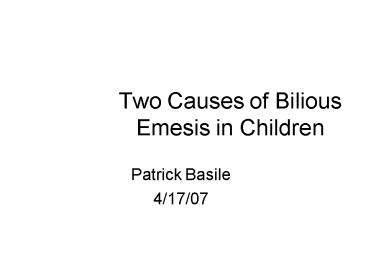Two Causes of Bilious Emesis in Children PowerPoint PPT Presentation
1 / 23
Title: Two Causes of Bilious Emesis in Children
1
Two Causes of Bilious Emesis in Children
- Patrick Basile
- 4/17/07
2
General Information
- Bilious distal to ampulla of Vater
- Presence of abdominal distension can correlate
with the level of obstruction - Lower the obstruction the larger the distension
- Meconium
- Passed in first 24 hours in 94 first 48 hrs98
- In newborn, cannot differentiate small from large
bowel by markings on plain abd film
3
Case 1
- At 6 hours of age a newborn is noticed vomiting
small amounts of mucus and bile stained fluid.
Physical exam is normal. During delivery, the
mother is noted to have large amounts of amniotic
fluid upon rupture of her membranes. - A plain abdominal film shows the following
4
Case 1
- What is the most likely diagnosis?
5
Duodenal Obstruction Ddx
- True atresia-Due to failure of recanalization of
duodenum early in gestation Twice as common as
atresia of jejunum of ileum (Papilla of Vater) - 50 with multiple congenital anomalies
- Downs Syndrome 20-30
- CHD 20
- Ladds Bands-peritoneal bands
- Mucosal webs as often as pure atresia
- Annular Pancreas
- Ventral bud of pancreas malrotates and tissue
persists
6
Ladds Bands
7
Duodenal obstruction- Clinical
Presentation
- Bilious vomiting without abdominal distension
- Hx of polyhydramnios in about 50
- Small for gestational age
- 50 with multiple congenital anomalies if true
atresia - Downs Syndrome 20-30
- CHD 20
- Others malrotation and esophageal atresia
- Meconium passed in 50 of cases
8
Duodenal obstruction- Dx/imaging
- Plain abd radiograph- double bubble sign
- Gas in small/large intestine indicates incomplete
obstruction - Upper GI series to check for malrotation
- Surgical emergency if present
9
Duodenal obstruction- Treatment
- Initial Tx
- Nasogastric/orogastric decompression with IV
fluid replacement - Treat co-existing life threatening anomalies
- Surgery
- Ladds Bands-division of band and correction of
malrotation - Atresia/annular pancreas-duodenoduodenostomy
- Web-excised with caution to not harm ampulla
- Exploration for concurrent distal obstruction and
atresia (1-3)
10
Atresia Surgery
- Side to side duodenoduodenostomy
11
Further Distal Atresia
- Due to mesenteric vascular accident in-utero due
to hernia, volvulus, intussusception - Leads to aseptic necrosis and resorption of
necrotic bowel. - Prevalence duodenal, proximal jejunum and distal
ileum respectively - Colonic is rare
- Different types are present
12
Case 2
- A 9 month old girl with a h/o intestinal polyps
presents with intermittent colicky abdominal
pain, appearing normal in between bouts of pain.
The frequency has recently increased and she has
begun to vomit bilious colored liquid. She also
passes stool that looks dark and gelatinous in
nature. Early PE was normal, but now a sausage
shaped mass sits in the right upper quadrant. - What is the most likely diagnosis?
13
Intussusception
- Telescoping of one portion of bowel
(intussusceptum) into an adjacent portion
(intussuscipiens) - Proximal portion into distal portion likely due
to peristalsis - Most common is ileocolic
- Terminal ileum into right colon 90
14
Intussusception
15
Epidemiology
- Incidence 1-41000
- Peak Incidence 5-12 months
- Range 2 mos- 5 years
- MF 2-41
- Most common cause of intestinal obstruction in
children
16
Causes
- Idiopathic
- Viral (enterovirus in summer and rotavirus in
winter) - link with rotavirus vaccine
- Lead points older children 2-10
- Meckels Diverticulum
- Polyps
- Lymphoma
- Henoch-Schonlein Purpura
- Cystic Fibrosis
- Hypertrophied Peyers patches
17
Presentation
- Classic Triad (only 20 of time)
- Intermittent colicky abdominal pain
- Bilious Vomiting
- Currant Jelly Stool (absence doesnt exclude)
- Neurological signs (can delay dx)
- Lethargy, shock-like state, seizure-like
activity, apnea - RUQ mass
- Sausage shaped that
- Ill defined
- Dances Sign-absence of bowel in RLQ
18
Diagnosis/Imaging
- AXR
- Lack of bowel gas
- Loss of visualization of liver
- Target sign-two concentric circles of fat
density - U/S
- Target or donut sign-single hypoechoic ring
with hyperechoic center - Pseudokidney sign- superimposed hypoechoic and
hyperechoic layers - Barium enema
19
US target/donut sign
20
Barium Enema
Cervix-like mass
21
Non-surgical treatment
- Correct for dehydration
- NG tube for decompression
- Contrast enema dx and tx in 60-80
- Only after resuscitation
- Contraindications
- Peritonitis, perforation, profound shock
- Will not reduce gangrenous bowel
22
Surgical Treatment
- Indications
- Unsuccessful enema reductions
- Signs of bowel perforation or peritonitis
- Laparotomy or Laparoscopically
- If non-gangrenous gentle retrograde compression
of intussuscipiens (distal), not traction of
intussusceptum - If gangrenous or non-reducible resection with
re-enastamosis.
23
Recurrence
- Radiographic reduction
- 3-10 recurrence
- Surgical reduction
- 1-5 recurrence
- Death due to delay of treatment for gangrenous
bowel

